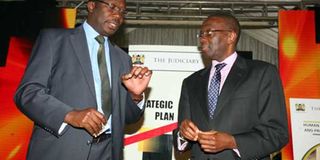Mutunga's blueprint seen as tool to salvage his legacy

Chief Justice Willy Mutunga (right) talks with Supreme Court Judge Smokin Wanjala at the Supreme Court of Kenya on November 19, 2015 during the launch of Judiciary Strategic Plan. PHOTO | EVANS HABIL| NATION MEDIA GROUP
What you need to know:
Critics say the CJ’s blueprint will amount to nothing if he fails to weed out corrupt officials.
And this week, the Nation reported that Dr Mutunga had suspended five magistrates for gross misconduct — ranging from having huge backlogs of judgements, to issuing orders without the contribution of all parties in a case.
In Dr Mutunga’s tenure, the Judiciary introduced a new system of paying fines through M-Pesa, transferred court clerks and other staff, and opened new High Court stations in various parts of the country, among other milestones.
As Chief Justice Willy Mutunga launched a strategic plan to guide the Judiciary’s projects up to 2018, not everyone thought the blueprint would amount to anything.
The plan, unveiled on November 19, contains guidelines on integrity of staff, modernisation of court registries, and sealing of holes in the Judiciary’s financial procurements, among other provisions.
MUTUNGA'S LEGACY
But two critics say the plan is but a tool to salvage Dr Mutunga’s otherwise weak legacy when he retires in June 2016.
Former chairman of the Mombasa branch of the Law Society of Kenya (LSK), Mr Eric Nyongesa, and Nairobi-based lawyer Edwin Sifuna told the Sunday Nation in separate interviews that Dr Mutunga has very few chances of leaving a solid legacy when he exits as head of the Judiciary.
And this week, the Nation reported that Dr Mutunga had suspended five magistrates for gross misconduct — ranging from having huge backlogs of judgements, to issuing orders without the contribution of all parties in a case.
EFFECTED REFORMS
The suspensions are part of a raft of actions that Dr Mutunga has taken recently to either revise the manner judicial officers conduct themselves or streamline issuance of bond and bail.
Another change introduced by the Judiciary is the revised transfer policy for judges and magistrates.
According to a new transfer policy, also released on November 19, no High Court judge or magistrate shall stay at a station for more than three years except if they are in a hardship area or if the Chief Justice approves of their stay, but for a maximum of five years.
In Dr Mutunga’s tenure, the Judiciary introduced a new system of paying fines through M-Pesa, transferred court clerks and other staff, and opened new High Court stations in various parts of the country, among other milestones.
In his October interview with former Ethics permanent secretary John Githongo, Dr Mutunga was asked to enumerate on what he thought would be his legacy.
“We are not talking about legacy here. A self-rendition of a legacy story is an exercise in vanity. I leave it to future historians to objectively deal with this question... I can, however, point out some reforms that we have achieved,” he said in the interview carried by The East African.
The reforms that he mentioned included creating an independent Judiciary, reducing case backlog, improving access to justice, operationalising new institutions from the Judicial Service Commission (JSC), making the Judiciary more friendly and accountable, consolidating the Kadhi Court system within the judicial system, expanding the number of Kadhis from 15 to 50 and ensuring no backlog in admission of lawyers to the bar.
“For most of these things, it is better to talk to judges, magistrates and staff who were in the Judiciary before I became CJ, to appreciate the magnitude of change,” he said.
BERNARD CHUNGA'S LEGACY
Regardless, Mr Nyongesa believes Dr Mutunga is a populist who “only looks at what is trending”.
“His decisions lack depth in terms of implementation,” said Mr Nyongesa, citing mobile traffic courts that he said were abandoned midway.
“Dr Mutunga has tried to stretch himself beyond the capacity he has. The decisions he makes are not structured to make sure they have a clear implementation mechanism,” Mr Nyongesa added.
Insisting that he has no personal vendetta, Mr Nyongesa said Dr Mutunga’s legacy is a far cry from what was done by Mr Bernard Chunga, who was Kenya’s Chief Justice between 1999 and 2003 when he opted to resign rather than be investigated.
“Mr Chunga rolled out policies and had the mechanisms to execute them. To me, Mr Chunga performed 10 times what Dr Mutunga has done,” he said.
FIGHT AGAINST CORRUPTION
For Mr Sifuna, Dr Mutunga’s failure to combat corruption in the Judiciary clouds all his efforts to inject reforms.
“It does not matter how many courts you build. As long as corruption exists, it is of little help. They are centres of corruption and nobody will honour you,” he said.
The advocate — known for leading Okoa LSK, a faction opposed to the Law Society of Kenya leadership — said the new rotation policy for judicial staff will amount to nothing as long as graft is not weeded out.
But in his interview with Mr Githongo, the CJ said there was remarkable progress in the anti-graft war.
“We are struggling hard and winning small and big,” the CJ said.





